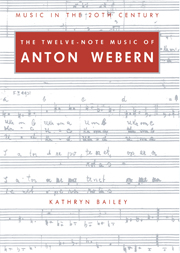Book contents
Summary
The twelve–note row is, as a rule, not a ‘theme’.
Although to equate a twelve–note row with a theme or melody is to take a simplistic view of the technique, it is nonetheless true that the construction of the row to be used as the basis for a dodecaphonic work is a process not entirely unlike the composition of the theme in a non–dodecaphonic work. It is at this point that decisions are made concerning which intervals and patterns will dominate in the ensuing work and shape its features. Webern's predilection for symmetry and logic and his preference for creating from limited material, as well as his leaning towards certain intervals, are evident in the make–up of his rows from the beginning.
That the minor second is a prominent element of most of Webern's rows will come as no surprise to anyone familiar with his earlier atonal music, in which the semitone and its permutations (the major seventh and minor ninth and the various compound intervals resulting from their enlargement by octaves) had always been favoured. Seventeen of the twenty–two rows considered in this study (including that of the unfinished Op. 32) exhibit semitone motion between adjacent notes in four or more places; in eleven of these, such motion occurs on more than five occasions.
In his earliest rows Webern seems to have been particularly concerned with limiting the number of intervals, presumably as a way of ensuring unity. This aim, in conjunction with his already well–established partiality for the semitone, produced rows that are heavily peppered with minor seconds.
- Type
- Chapter
- Information
- The Twelve-Note Music of Anton WebernOld Forms in a New Language, pp. 13 - 29Publisher: Cambridge University PressPrint publication year: 1991
- 1
- Cited by



